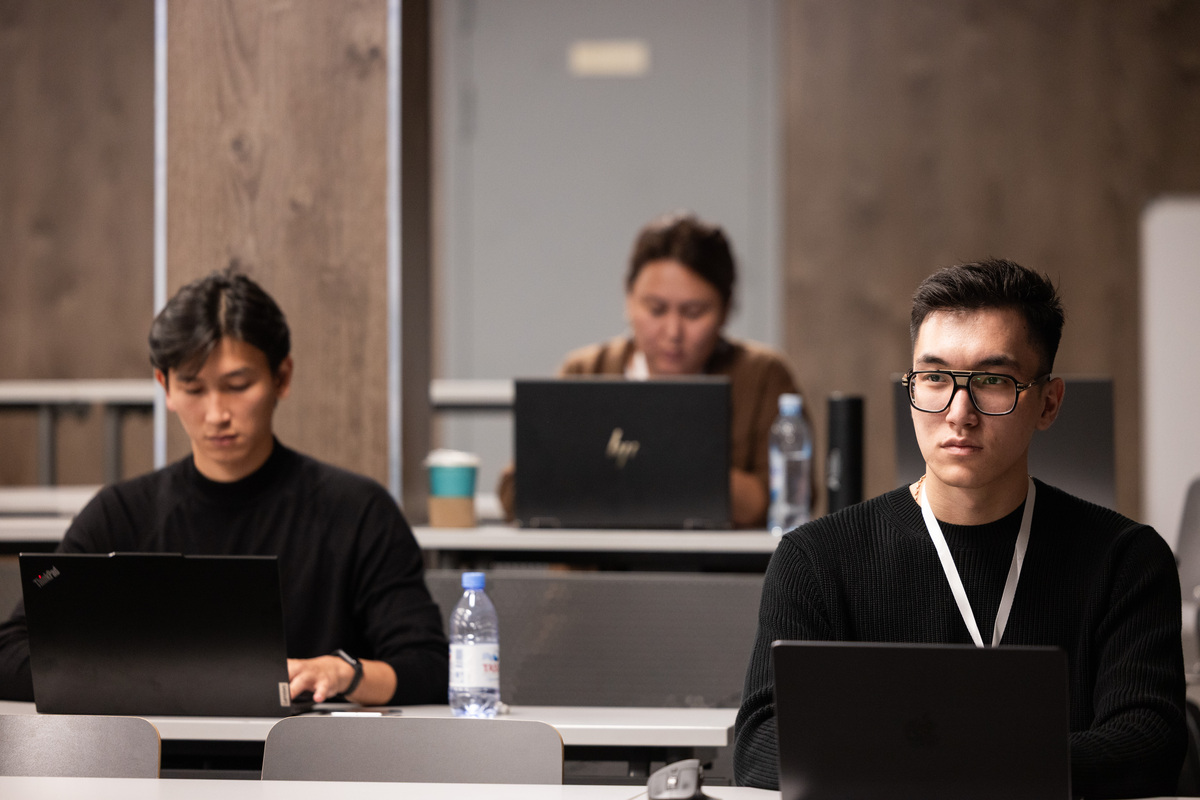Almatinians launch innovative startup streamlining recruiters' routine tasks. Explore how it works.

At just 21 years old, Akezahn Umarov has already gained significant business experience. During his 10th-grade year, he joined a marketing agency. Subsequently, he established the “Beyond Borders” anti-motivational forum, featuring renowned entrepreneurs such as Oskar Hartmann, Nurlan Smagulov, Evgeniy Chernyak as speakers. Concurrently, he and his friends created a mobile application offering training courses, which rapidly attracted 13 thousand paying users before they successfully sold it.
Currently, alongside Dimash Sabitov and Dilfuza Abdraimova, Akezhan is actively involved in developing the startup SoBes—an HR system designed to automate the recruitment process, particularly for B2B operational personnel. In an interview with the collaborative initiative of Digital Business and Astana Hub, “100 Startup Stories of Kazakhstan,” the young entrepreneur revealed insights into how they successfully expedited the hiring process, the strategies that enabled the small startup to secure the largest bank in Kazakhstan as a client, and the reasons behind the decision not to seek external investments.
“The HR department receives a higher-quality pool of candidates and engages with those who best align with the requirements”
– According to the SoBes website, your online interview system is designed to expedite, simplify, and enhance the transparency of the hiring process, ensuring the selection of the best candidates. Could you please share how this is achieved?
– To provide a broad overview, let me outline the typical recruitment process. Initially, a recruiter posts the job opening on various platforms such as HeadHunter, social networks like Facebook and Instagram, and specialized chat channels. Subsequently, the recruiter begins receiving applications, which then require filtering to eliminate irrelevant ones.

The subsequent step involves giving feedback to applicants who, in one way or another, meet the requirements. This may include sending a message or making a call to clarify certain details. Following this, the recruiter sends a test assignment or extends an invitation to a meeting where questions can be addressed, exams can be taken, and so forth.
When dealing with operational personnel, about a dozen individuals may be involved in completing all these stages for a single position. This process typically spans a minimum of 2-3 weeks. The extended waiting period for feedback leads to the disappearance of many candidates. According to statistics, only 7% of the total number of applicants who submitted their CVs make it to the end of the interview process. Consequently, the employer often ends up hiring a candidate who successfully reaches the final stages.
We propose transferring the initial assessment of candidates' skills to the system. With integration across various job platforms, including WhatsApp Business API, our chatbot contacts the candidate after the application, providing instructions and sending a link for an online interview. Once completed, the system notifies the recruiter and presents the results by ranking candidates based on their point scores.
The entire process, from application to employment, now takes only 3-7 days instead of several weeks. The immediate contact by the chatbot with the candidate, guiding them to the interview stage, has led to a 35% increase in the number of interviewed candidates. As a result, the HR department receives a higher-quality pool of candidates and engages with those who best align with the requirements.
– Can you provide a concrete example demonstrating how your system has significantly streamlined the operations of an HR department?

– We assisted the educational center "Just to Study" in hiring 400 tutors with the efforts of a single HR specialist in just six months. Previously, recruiting such a large number of specialists would have necessitated three recruiters and taken at least twice the time.
The chatbot swiftly reached out to candidates, dispatched skill-testing tasks, and subsequently presented a recruiter with a list of the top performers. Following this, the HR specialist extended invitations to selected candidates for internships.
– What is the mechanism for recruiters working with your service? Given that each position comes with specific requirements, there are corresponding interview nuances.
– The system features a constructor comprising various tools, allowing each recruiter to choose the ones that best suit their needs. For instance, they can add multiple-choice tests during the interview or incorporate written responses. Additionally, recruiters have the option to request candidates to record audio or video responses lasting several minutes.
In the admin panel, recruiters have the capability to add any questions that the chatbot will pose to the candidate. By the first quarter of the next year, we aim to introduce a feature where the system will analyze these questions and assess their alignment with the specified requirements.

Recently, we integrated the CRM system and walkthrough analytics. Now, recruiters can access a comprehensive overview of the interview process, including insights into which candidates dropped off at specific stages, as well as identifying those with the best results in testing assignments, and more.
It's also feasible to evaluate which recruiting channels were most effective. For instance, there were 100 applications from HeadHunter, but only one candidate progressed to the final stage. On the other hand, from Linkedin, there were 10 candidates, and half of them received job offers. This implies that, in the future, allocating more resources to Linkedin may be more strategic.
– Can a candidate manipulate your system? For instance, in the case of a test, could they potentially seek and find answers on the Internet?
– There is such a possibility, but we have implemented several protective mechanisms. For instance, it is possible to impose a time limit on the interview process, such as providing 20 minutes to answer 20 questions, preventing candidates from having the opportunity to search for answers online. Another safeguard is the availability of a one-time link that restricts candidates from retaking the interview.

We are prepared to offer customized solutions, and we are currently integrating proctoring—a system that monitors screen activity. It captures a screenshot every 30 seconds, providing visibility into the candidate's actions, all with their consent, of course.
– Is it possible for a candidate to pose questions to the chatbot?
–Currently, it is not available on a broad scale. In the pilot mode with one client, we have integrated a WhatsApp chatbot with diverse AI models capable of sustaining dialogue based on scripts crafted by recruiters. Furthermore, this feature is adaptable to various languages, including Russian, Kazakh, and English.
“Throughout our operational history, we have conducted over 18 thousand interviews through our platform”
– Who is your main client at present?
– Our primary focus is on medium and large businesses located in major cities, with a workforce of at least 100 employees. This emphasis is due to the statistical observation that 24% of the working population in Kazakhstan changes jobs annually, with megacities displaying a clearly defined trend in this regard.
Currently, our optimal locations are Almaty, Astana, Shymkent, and Atyrau. Our clientele encompasses educational centers, pawnshops, tourism agencies, MFOs, and various other entities with a need for office personnel recruitment.

– How many companies are currently utilizing SoBes?
–We initiated the product launch in April, and since then, we have onboarded 40 companies. Among them, 20 companies are currently active, meaning they are paying a monthly subscription fee.
The initial challenge stemmed from entering the market with an unfinished product. Initially, recruiters had to manually reach out to candidates via WhatsApp, send interview links, provide instructions, and consistently follow up. This resulted in low system adoption, with a retention rate not surpassing 10%. After subsequent improvements, the situation transformed, and the retention rate surged to 70%.
–Recently, the largest bank in Kazakhstan became your client. As a relatively small startup that entered the market less than six months ago, how were you able to secure an agreement with them?
– Our network played a crucial role. I organized a forum where the chairman of the bank's board was a speaker, allowing me to connect with various employees. Through their assistance, I secured a meeting with the HR Director, where I presented our product and shared successful cases. One notable example involved a pawnshop, where our solution facilitated the hiring of 200 sales managers in half the time, resulting in savings of at least 35 million tenge.

Following discussions, we reached an agreement with the bank for a pilot project to recruit consultants for their branches in different cities. Achieving positive results, we subsequently finalized an annual contract.
– Am I correct in understanding that your monetization model involves a subscription?
– Partially. Our revenue model involves selling packages based on the specific number of interviews: 500, 2,500, and 10,000. Charges are applied only for those candidates who successfully complete the interview process. The pricing for each lead varies from 100 to 200 tenge, contingent on the volume of the purchased package—larger packages come with lower prices.
For instance, a package of 500 interviews is priced at 75 thousand tenge and remains valid for one year. If unused within this period, the interviews expire. Overall, the revenue from subscriptions for the entire period exceeds 6 million tenge, with October alone contributing 3 million tenge.
– Approximately, how many individuals are employed each month with the assistance of SoBes?
– Only recently, perhaps since July, we commenced a gradual expansion of our sales, making it challenging to provide an average monthly figure. For instance, in April, only 25 individuals completed the interview process. By October, this number increased to 3.5 thousand, even though our client base did not significantly grow during this period. These figures were achieved in collaboration with the companies we were already working with.
Throughout the entire period, our platform has facilitated over 18 thousand interviews, leading to the hiring of 1.3 thousand employees. Based on our calculations, if we maintain this pace, we anticipate reaching profitability by September 2024.

“The subsequent phase involves developing an AI-based recruiter assistant that will be tasked with crafting job vacancies and formulating interview questions”
– Given that the project is not currently generating profit, where did you secure the funding?
– The funding comes from internal investments of the partner company. Overall, we have invested approximately 60 million tenge in the project. Based on our calculations, reaching operational profit in Kazakhstan will necessitate a similar amount, if not more. However, we are prepared for this.
Collaborating with partners, we have allocated a budget of 410 million tenge for SoBes. Essentially, these funds constitute our pre-seed and seed rounds, which we plan to close independently. This amount is expected to be sufficient for achieving stability in Kazakhstan and facilitating a launch in one of the countries in Southeast Asia. Subsequently, when the time for Series A arrives, we will actively seek additional funding sources.

– What led to the decision not to seek early-stage funding from venture investors, a path that many Kazakhstan startups typically take?
– We hold the belief that the longer a project can sustain itself without relying on third-party funding, the more advantageous it is. This autonomy grants greater freedom in decision-making and actions. Additionally, we are hesitant to relinquish a significant portion of the project at its early stages, especially considering the usual lower valuation.
Furthermore, given the financial capabilities of our partner, there's currently no imperative need for external funding as we can navigate independently.
Nevertheless, we are considering bringing advisors into the project. Currently, we already provide monthly project reports to Oskar Hartmann, and he endorses the direction we are pursuing.
– You mentioned the intention to launch in one of the countries in Southeast Asia. Could you specify which country you are considering?
– We find Indonesia appealing. It boasts numerous potential clients in the B2B segment, a strong penetration of technology in society, and a rapidly growing economy expected to soon rank among the top 10 in the world.

My partner and I have already purchased tickets to Jakarta for the end of January. We plan to spend a couple of weeks there to familiarize ourselves with the local market. This trip will serve as a test run. We have scheduled meetings with representatives from 10 companies, during which we will present our solution and attempt to secure initial sales. Additionally, we have translated our platform into English and are on the verge of launching the Indonesian version soon.
We have conducted a preliminary market analysis and found no solutions similar to ours. Our next step is to gather feedback from companies and assess the demand for our service.
–Apart from translating the platform into other languages and integrating with various AI models, what other features are you planning to add to the product?
– Our upcoming initiative includes the creation of an AI-based recruiter assistant responsible for generating job vacancies and crafting interview questions. Interestingly, we've already experimented with this for our startup. In the quest for a senior developer, we employed a neural network to draft the job vacancy. After making some adjustments suggested by the CTO, we posted it on various platforms.
Upon receiving applications, we once again turned to AI, this time requesting the generation of 15 interview questions. The outcome was quite satisfactory. Our next challenge is to figure out how to train the neural network to consistently produce high-quality scripts for various positions.

– Our interview might suggest that in the future, SoBes could potentially replace recruiters entirely, leaving them without jobs…
– Our goal is not to replace recruiters but rather to create an exoskeleton that enables them to efficiently and effectively fill positions. This approach allows recruiters to dedicate more time to shaping corporate culture, eliminating the need for routine tasks. Additionally, the use of analytics enables a more strategic allocation of the company's resources, resulting in mutual benefits for all involved.
Another crucial aspect is that none of our clients have laid off recruiters. While some may refrain from hiring new ones, the discussion doesn't revolve around terminations. In any case, the neural network lacks the capacity to finely tune aspects like attracting employees, onboarding, and cultivating a corporate culture and a healthy team atmosphere.
In the USA, there's a startup similar to ours that has been active in the market for several years. Despite its presence, this product has not managed to replace the HR department. Moreover, there's no assurance that anyone will achieve this in the near future.





